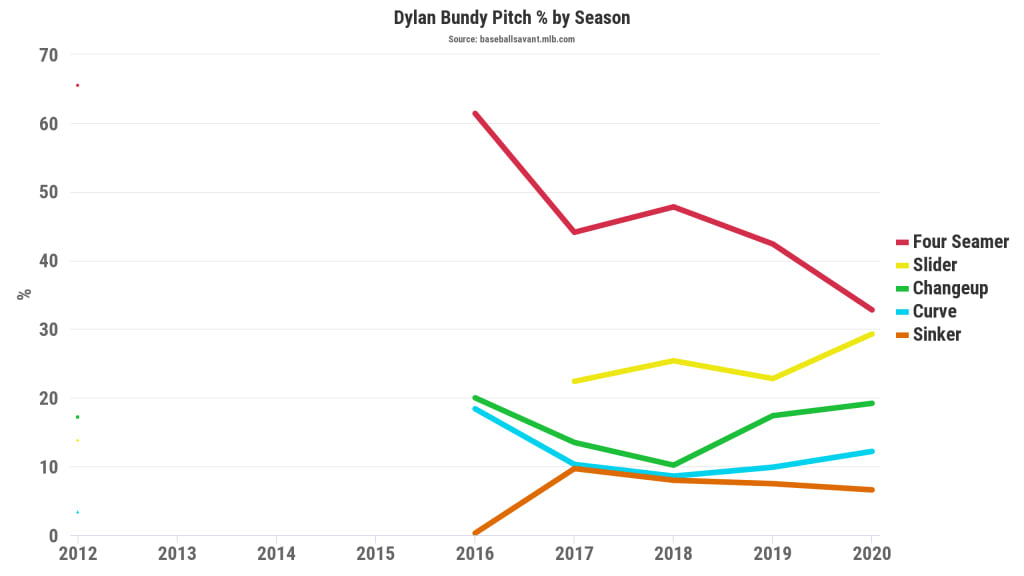Entering the offseason, there was no question the Angels needed to improve their starting pitching. The team had a 5.64 starters ERA last season, better than only one team: the Rockies (5.87). But they didn’t get any of the big-name free-agent pitchers on the market, including Orange County native Gerrit Cole.
Nonetheless, it appears that the Angels’ Dec. 4 trade for Dylan Bundy was, unexpectedly, one of the best moves of the offseason.
The Orioles selected Bundy fourth overall in the 2011 MLB Draft. The right-hander debuted briefly in 2012, but battled injuries early in his career and had uneven results since returning to the Majors in 2016, taking a 4.58 career ERA into 2020.
So when the Orioles traded him to the Angels in early December, it didn’t necessarily feel like a move that’d end up anchoring the Halos’ rotation. Bundy would provide some much-needed innings, but the quality of those innings was in question. Instead, he’s been the best pitcher on a starting staff that has defied expectations with a 4.44 ERA -- tied for 16th in the Majors entering Monday. That’s nothing to write home about, but a far cry from where the team was a year ago.
Bundy enters his fourth start of the year Tuesday against the A’s with a 2.08 ERA, eighth-best among qualified American League starters. In his last start on Aug. 6 at the Mariners, he struck out 10 and did not walk a batter in a one-run complete game, the third of his career.
The problem
Prior to 2020, Bundy had a slider that he’d begun using in 2017, which had been a good pitch for him. Bundy had a sub-.200 opponent batting average on his slider in both 2018 and ‘19, coupled with a whiff rate of at least 47%.
But he had never used it more than 25.4% of the time in a season, with a large gap between that and his four-seam fastball usage, which was over 40%.

Bundy’s four-seamer didn’t just get hit hard -- it got smoked. The .645 slugging percentage he allowed in at-bats ending on the pitch last year was third-highest among pitchers with at least 150 at-bats ending on four-seamers, behind only Jeff Hoffman (.741) and Nick Pivetta (.697).
Opponent BA/SLG vs. Bundy’s four-seamer since 2016
2020: .231 / .423
2019: .335 / .645
2018: .303 / .576
2017: .255 / .431
2016: .276 / .455
And when he allowed 41 home runs in 2018, 20 of those came on four-seamers. There have been just 12 instances in the pitch-tracking era (since 2008) of a pitcher allowing more four-seamer home runs in a single season.
The solution
One of the first things that stands out about Bundy’s 2020 is his increased slider usage (29.3%). He’s had success with it, too, allowing just one hit in 23 plate appearances ending on the pitch. His .045 opponent batting average in at-bats ending in sliders is third among starters (min. 10 PA ending on sliders), behind only Anthony DeSclafani and German Marquez.
And it isn’t just the fact that batters aren’t hitting Bundy’s slider -- it’s what they’re doing instead. He’s generated a 55.6% whiff rate on swings against his slider. That ranks third among pitchers to get at least 25 swings against their slider this season, behind only Max Scherzer (75.0%) and Tyler Kinley (60.7%).
The overall theme here is an increase in use of his secondary pitches, which also includes his changeup and curveball. Overall, Bundy is throwing non-fastballs 60.6% of the time this season, by far the highest rate of his career. Last year, he used those pitches a career-high 50.1% of the time.
Bundy’s four-seamer & slider usage rates since 2017
2020: 32.8% / 29.3%
2019: 42.4% / 22.8%
2018: 47.8% / 25.4%
2017: 44.1% / 22.4%
He’s also allowed a combined .091 batting average in at-bats ending on his secondary pitches, tied with 2017 for the lowest in his career. That is tied for sixth-lowest among pitchers with at least 20 at-bats ending on non-four-seamers and sinkers.
The 2020 version of his four-seamer doesn’t look that different from the one he’s had in the last few seasons: similar spin rate, generating a similar whiff rate. But the ability to mix in more of his secondary pitches and have success with them has likely played a role in improving the results on the pitch this season. When an at-bat against him isn’t a guaranteed fastball, the entire tenor changes.
To that point, he’s using his four-seamer on the first pitch of plate appearances just 32.5% of the time. It’s been above 50% in every other season of his career, aside from 2017 when it was 49.2%. And he’s allowing less hard contact overall, with an 85.4 mph average exit velocity, which would be the lowest he’s allowed since Statcast began tracking in 2015. His average exit velocity allowed had been at least 88 mph from 2017-19.
Looking ahead
There’s evidence beyond Bundy’s pitch selection to indicate this isn’t just a fluke.
His 31.3% strikeout rate would be the highest of his career, and his 2.5% walk rate would be the lowest. He’s not just throwing different pitches, but is also getting different and better results across the board -- ones that point to future success.
Bundy’s expected stats agree with that assessment, too. His expected batting average (.181) and slugging percentage allowed (.318), ranked fourth and 10th, respectively, among 95 pitchers who had faced at least 50 batters through Sunday. His 2.09 expected ERA ranked third in that group, almost exactly matching his actual ERA of 2.08. All of that suggests he hasn’t gotten lucky, but has allowed the type of contact in line with the results he has gotten.
This is a clear change in approach for Bundy, and it’s worked for him so far. If he keeps it going on Tuesday night against the A’s, and beyond, it will be huge for an Angels club trying to fight its way out of an early hole in the standings.
